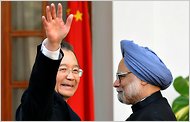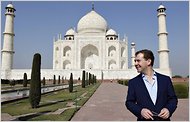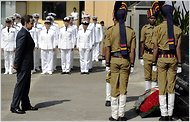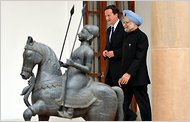Ilankai Tamil Sangam30th Year on the Web Association of Tamils of Sri Lanka in the USA |
||||||||||
 Home Home Archives Archives |
India Digs In Its Heels as China Flexes Its Musclesby Jim Yardley, The New York Times, December 29, 2010
NEW DELHI — It has been the season of geopolitical hugs in India — with one noticeable exception. One after the other, the leaders of the five permanent members of the United Nations Security Council have descended on India, accompanied by delegations of business leaders, seeking closer ties with this rising South Asian giant. The Indian media, basking in the high-level attention, have nicknamed them the “P-5.” CHINA Prime Minister Manmohan Singh of India in New Delhi on Dec. 16 with Prime Minister Wen Jiabao of China, the last of five leaders representing the permanent members of the United Nations Security Council to visit India in recent months. Prime Minister David Cameron of Britain got a warm reception last summer. Then President Obama wowed a skeptical Indian establishment during his November visit. President Nicolas Sarkozy of France signed nuclear deals in early December, while President Dmitri A. Medvedev of Russia departed last week with a fistful of defense contracts after winning praise for Moscow as a “special partner.” The exception to the cheery mood was the mid-December visit of Prime Minister Wen Jiabao of China. Mr. Wen did secure business deals, announce new trade goals and offer reassurances of friendly Chinese intentions. But the trip also underscored that many points of tension between the Asian giants — trade imbalances, their disputed border and the status of Kashmir — are growing worse. And the Indian foreign policy establishment, once reluctant to challenge China, is taking a harder line.
“The Wen visit has widened the gap publicly between India and China,” said Ranjit Gupta, a retired Indian diplomat and one of many vocal analysts pushing a more hawkish line toward China. “And it represents for the first time a greater realism in the Indian establishment’s approach to China.” India aspires to membership on the United Nations Security Council, and China is now the only permanent member nation that has not explicitly endorsed such a move. But what has rattled Indian leaders even more is their contention that China is being deliberately provocative in Kashmir as it grows closer to Pakistan, China’s longtime ally and India’s nemesis. China has also been expanding its diplomatic and economic influence around South Asia, stepping up its involvement in the affairs of Sri Lanka, Nepal and the Maldives.
Mr. Wen’s visit was supposed to help address those tensions at a time when India is starting to draw closer to the United States. Among Chinese leaders, Mr. Wen is perceived as a friend of India, and his 2005 visit was regarded as a breakthrough after he and Prime Minister Manmohan Singh agreed on a broad framework to address the border dispute. For decades since fighting a brief border war, the two countries had argued over the boundary lines, with China making claims to Arunachal Pradesh, an eastern Indian state, and India claiming portions of Tibet that abut Indian-controlled Kashmir. The 2005 deal fostered optimism that some sort of quid pro quo compromise could be reached, enabling the two countries to concentrate on trade. And trade took off: it has risen tenfold to almost $60 billion, with Mr. Wen setting a new goal of $100 billion. But Indian leaders now complain that trade is far too lopsided in China’s favor and say that Indian corporations face too many obstacles in entering the Chinese market. Mr. Wen promised to help Indian corporations sell their products in China, but Indian officials are skeptical.
Meanwhile, China infuriated India by starting to issue special stapled paper visas — rather than the standard visa — for anyone in Indian-controlled Kashmir traveling to China on the grounds that Kashmir is a disputed territory. China later objected to including a top Indian general responsible for Kashmir in a military exchange in China. In response, Indian officials angrily suspended all military exchanges between the countries. Indian officials had thought Mr. Wen might reverse the stapled visas policy on his trip, but he instead only called for more diplomatic consultations. Indian commentators have noticed that articles in the Chinese state-run media have renewed Chinese claims that the disputed border between the nations is roughly 1,240 miles in length — even as India puts the length at about 2,175 miles. The difference roughly represents the border between Indian-controlled Kashmir and Tibetan China. By omitting this section, the Chinese are questioning the status of Indian-controlled Kashmir, a position that buttresses Pakistan’s own claims, several Indian analysts have argued. The most visible evidence that these problems were deepening came in the joint communiqué issued by the two nations at the end of Mr. Wen’s visit. China typically demands that nations voice support for the one-China policy, which holds that Taiwan is an inalienable part of China. In past communiqués, India has agreed to such language, but this time it was omitted, a clear sign of Indian irritation.
“It has been in every communiqué, but the Chinese didn’t even bring it up,” said a senior Indian official, speaking on the condition of anonymity. “I think they knew if they had brought it up, they knew we would have demanded some movement on the stapled visa issue and the Kashmir issue.” The senior official added: “They must understand that there is a prospect of the relationship really going south. They will have to somehow moderate their stand on Kashmir. And they will have to take concrete steps to address the trade imbalance.” India and China still cooperate on climate change and international trade policy, and some Indian diplomats grumble that the positive aspects of the relationship are too often overlooked by aggressive media organizations and an emboldened group of strategic analysts pushing for a harder line. China’s state-run media outlets recently broadcast images of a new tunnel being completed through the Himalayas near the Indian border. These reports looked to some like boasting about the country’s engineering prowess. In India, they were presented as a warning that China was building its infrastructure ever closer to India. At the same time, India is watching warily as China pursues hydro projects that could affect the downstream flow of the Brahmaputra River in India. Some Indian analysts note that tensions with China have increased in lockstep with the warming trend between India and the United States. During his visit, Mr. Obama spoke of a “defining partnership” between India and the United States and encouraged India to play a bigger role not only in South Asia but also in East Asia, China’s backyard. Mr. Singh, in fact, had just finished a trip to Japan, Malaysia and Vietnam as part of India’s “Look East” policy to build trade and diplomatic ties in the region. “Our challenge will be to build our own leverage,” the senior Indian official said. “That is why the relationships with the United States, with Japan, with other Southeast Asian parties, all that will become even more important.” |
|||||||||
|
||||||||||




